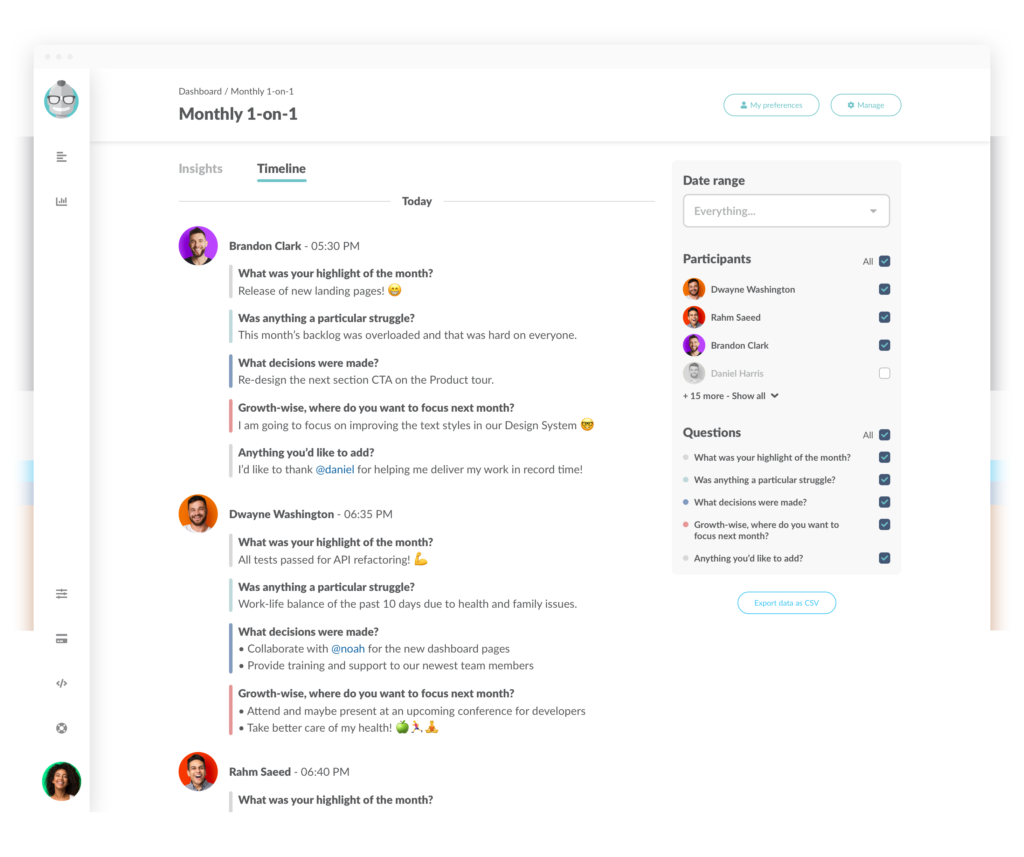Managers often treat employee satisfaction as a given. According to HBR, there are a plethora of reasons why dissatisfied workers don’t quit their jobs, ranging from family responsibilities and lack of opportunities to work ethic and the power of habit.
But dissatisfied employees that keep working are less productive, less happy, and less engaged in their jobs than satisfied employees. In other words, if your employees are dissatisfied, you’re losing in more ways than you might think.
In this article, we’ll talk about why employee satisfaction is so crucial at the modern workplace, how to properly measure employee satisfaction, and how to keep your employee satisfaction at an all-time high.
Why Employee Satisfaction Is Crucial For Your Company Bottom Line?
If your average employee satisfaction is low, you’re losing more money than you think. According to Gallup, a single disengaged employee may cost your company up to 34% of their annual salary. On top of that, disengaged employees have 37% higher absenteeism, and 15% lower profitability.
On the other hand, there are major benefits to keeping your employees’ satisfaction high:
- Satisfied employees are more productive. According to Bain’s research, satisfied employees are 44% more productive than dissatisfied ones.
- Satisfied employees are more motivated. Research from Work.Life shows a direct connection between employee happiness and motivation.
- Satisfied employees are more innovative. One of the common sources of employee dissatisfaction is the lack of purpose in work. At the same time, mission-driven companies boast 30% higher levels of innovation.
Any of these employee satisfaction benefits can be attached to your business bottom line. Employee productivity has a direct correlation with a company’s performance. Highly motivated teams show 21% greater profitability. And innovative companies are more profitable in general.
But keeping your employees satisfied is a challenging task, especially in a modern and constantly changing digital environment. The challenge comes from both measuring employee satisfaction and keeping it at high levels.
Let’s start with learning about how to measure your employee satisfaction.
How to Measure Employee Satisfaction
#1. Go With Hard Numbers — Employee Satisfaction Index [ESI] and eNPS
Best for: quickly establishing employee satisfaction baseline
There are two metrics commonly used for measuring employee satisfaction at a workplace: Employee Satisfaction Index (ESI) and Employee Net Promoter Score (eNPS).
Both metrics rely on scale-based questions, but they measure different things:
- ESI measures : how satisfied your employees are with their workplace,
- eNPS measures : how likely employees will recommend their employers to someone.
The key difference between ESI and eNPS is that ESI includes several questions (typically three) whereas eNPS just one.
How to measure ESI :
Send your employees the following series of questions:
- On a scale from 1 to 10, how satisfied are you with your current workplace?
- On a scale from 1 to 10, how well does your current workplace meet your expectations?
- On a scale from 1 to 10, how close is your current workplace to the ideal one?
Calculate ESI for every employee using this formula:
ESI = (Questions Received Value divided by Max Question Value) x 100
Suppose you sent three “On a scale from 1 to 10…” questions to your employee and these were their responses:
- Question 1: “8”
- Question 2: “7”
- Question 3: “3”
Here’s how to calculate ESI :
Questions Value = All question received scores summed up divided by the maximum possible score of all questions
– Questions Received Value = (8 + 7 +3) = 18
– Max possible score of all questions = 10 *3 =30 ( the maximum score per answer is 10 and there were 3 answers)
– ESI = ( 18 / 30 ) * 100 = 60.
*Your ESI for this participant is 60, which is closer to a negative score.
Note: The minimum ESI value would be 0, which means your employees are extremely dissatisfied. The maximum ESI value would be 100, which means your employees are extremely satisfied with your workplace. An ESI rating of 80 percent or higher represents high employee satisfaction. Any ESI below 60 percent signifies low satisfaction among employees.
ESI score should be calculated for each employee separately. Later you can gather all the responses in one place using an Excel sheet or slack bots such as Geekbot to automate the whole process.
How to measure eNPS :
Send your colleagues the following question:
- On a scale from 0 to 10, how likely would you recommend our organization to a friend or acquaintance?
Divide all the responses into three groups (0-6 are called “detractors”, 7-8 “Neutral” 9-10 “Ambassadors)
As there’s a connection between employee satisfaction and eNPS, you can see the big picture of how many employees are satisfied with their workplace.
#2. Go With Your Gut Feeling — Conduct Personal 1-on-1s
Best for: finding deep-underlying issues within teams
When conducted properly, one-on-one meetings with employees provide benefits such as increased employee engagement, boosted performance, and enhanced team alignment.
But above anything, 1-on-1 sessions are a great way to gauge your employee satisfaction. The biggest advantage of 1-on-1 sessions is that they can be customized to focus on a specific issue or theme.
For example, you can include the following questions in your session:
- If there was one thing I could do to help you, what would it be?
- On a scale of 1-10, how happy are you with your work-life balance?
- How can we get you closer to 10?
- Is there anything that slows you down in the workplace?
- Growth-wise, where do you want to focus next month?
By asking targeted questions you can learn more about your employees’ goals and reveal any issues that affect their satisfaction. You can combine these sessions with ESI & eNPS data to track how effective your 1-on-1 sessions are over time.
Note: you can better prepare for 1-on-1 meetings with Geekbot. Simply send several prep 1-on-1 questions before the main session starts so that you know what to focus on during the meeting with your employee.
#3. Conduct Employee Satisfaction Surveys
Best for: remotely distributed teams who are tired of useless log-winded meetings and surveys
Although remote teams struggle with many issues, among the most prominent are the abundance of useless meetings and, ironically, the lack of communication data.
When trying to measure employee satisfaction, you risk running into both: either you schedule too many meetings that your team perceives as a burden, or you end up with a couple of ESI metrics and have no idea how to follow up on them.
This is where automated employee satisfaction surveys come in handy as they allow you to combine the benefits of traditional employee satisfaction metrics (ESI and eNPS) and the flexibility of 1-on-1 sessions with every employee.
Here’s how to conduct automated employee satisfaction surveys in Geekbot:
Open Geekbot dashboard and choose “Team Feedback” template:

Decide what questions you’d like to send, who will receive them, and how often.
It’s best to combine scale-based questions (e.g. eNPS, ESI, or similarly structured) with personalized questions (check the above “One-on-One questions” section).
Geekbot will automatically send the questions at the selected time and will store all the responses in the designated Slack or MS Teams channel:

In the settings, you can also choose the replies to be anonymous so that team members would feel more at ease.
Use the Geekbot dashboard to analyze all the replies in one place.

In addition to that Geekbot can automatically build a real-time dashboard of your team happiness based on their responses.

You can continue the discussion using slack Threads or add more questions to these automated satisfaction surveys based on your experience.
The key to success here is to regularly update personal questions and keep track of scale-based responses over time to reveal employee satisfaction dynamics.
Questions for Employee Satisfaction Surveys
You can use the following questions as an inspiration for your employee satisfaction surveys.
- How valuable is your feedback to your managers?
- How would you rate your overall job satisfaction on a scale of 1 to 5?
- Is there an equal chance for all employees to be promoted in the organization?
- What do you think of the company’s vision and mission? Would you rate it as extremely important, important, neither important nor unimportant, unimportant, or extremely unimportant?
- Generally speaking, how would you describe the feeling that you get from doing your job well?
- How meaningful is your work to you?
- Are you happy at work?
- As a company, how open to change are we?
- How well do you get along with your coworkers?
- Are you planning to work for the same organization in 3 years?
- In your opinion, does the work you do have a positive impact on others?
- Are you subjected to a great deal of stress at work?
- Is there an even distribution of work among your team members?
- How well defined are your responsibilities in your current position?
- Are your superiors communicating company goals effectively and on time?
- Do you think your manager values you?
- How often do you receive constructive feedback from your manager?
- Are you able to develop yourself and improve your skills at work?
- Do you participate in the process of making leadership-related decisions?
- When it comes to making better decisions, do you have a hard time getting information?
- How well does your manager understand work life and personal life balance?
Keeping Your Employee Satisfaction High
The best way to keep your employee satisfaction high is to hear them.
Tobi Lütke, Shopify’s CEO, describes the concept of a trust battery within their company:
“It’s charged at 50 percent when people are first hired. And then every time you work with someone at the company, the trust battery between the two of you is either charged or discharged, based on things like whether you deliver on what you promise.”
There’s the same battery for employee satisfaction. When people first get hired, their work satisfaction is at about 50%. With time it either increases, producing benefits such as improved performance and innovation, or decreases, spawning absenteeism and disengagement.
It’s your job to learn what charges and discharges your employee satisfaction battery and right the wrongs before it’s too late. Hopefully, the methods mentioned in this article will help you achieve that in the most efficient manner.
At Geekbot we offer a free 10-people plan for you to try all the techniques mentioned in this article.
Joining thousands of highly successful teams such as Shopify and Github that already use Geekbot and every day take their work to the next level.
Frequently asked questions
How does job satisfaction affect employee performance?
Studies show that there’s a direct connection between employee performance and employee satisfaction. Low employee satisfaction leads to increased absenteeism and lower productivity. And the same time, high job satisfaction leads to increased motivation, innovation, and profitability.
What makes an employee happy?
There’s no way of saying what makes every employee happy as every employee has their own priorities and motivations. Prominent happiness-inducing factors include healthy work and life balance, fair compensation, sense of purpose in work, a sense of appreciation, team relationships, and a comfortable working environment.
What are companies doing to keep employees happy
To keep employees happy companies first need to understand what makes their employees happy by conducting employee satisfaction surveys. Often companies can provide employees with benefits such as the ability to work from home, fair compensation, various bonuses, and accomplishment recognition.



